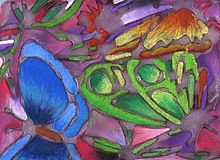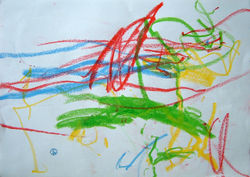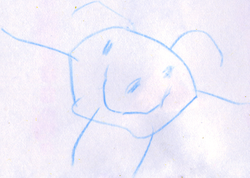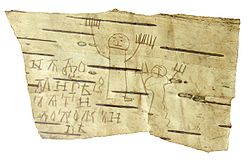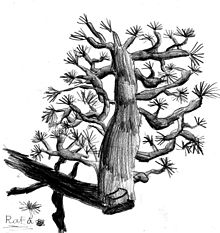- Child art
-
Three Butterfly, 14 aged-girl made by chalk and glue on kraft paper

Child art is the drawings, paintings and other artistic works created by children. It is also referred to as "children's art" or the "art of children".
The term 'child art' also has a parallel and different usage in the world of contemporary fine art, where is refers to a sub-genre of artists who depict children in their works.
Contents
"Child art"
There is a third use of the phrase "child art" in the literature; art intended for viewing by children, say illustrations in a book for juvenile readers, has been referred to as child art; such art could be done by a child or a professional adult illustrator.
Stages of child art
As the child develops, their art passes through a number of stages. It is thought that all children pass through these stages.
Scribbling
From about their first birthday children achieve the fine motor control to handle a crayon. At first they scribble. The youngest child scribbles with a series of left and right motions, later up down and then circular motions are added. The child appears to get considerable pleasure from watching the line or the colours appear. Often however children do not pay attention to the edges of the page and the lines go beyond the confines of the page. Children are often also interested in body painting and, given the opportunity, will draw on their hands or smear paint on their faces.
Later, from about their second birthday, controlled scribbling starts. Children produce patterns of simple shapes: circles, crosses and star-bursts. They also become interested in arrangement and can produce simple collages of coloured paper, or place stones in patterns. Once children have established controlled scribbling they begin to name their scribbles.
Pre-symbolism
From about age three, the child begins to combine circles and lines to make simple figures. At first, people are drawn without a body and with arms emerging directly from the head. The eyes are often drawn large, filling up most of the face, and hands and feet are omitted. At this stage it may be impossible to identify the subject of the art without the child's help.
Later drawings from this stage show figures drawn floating in space and sized to reflect the child's view of their importance. Most children at this age are not concerned with producing a realistic picture.
Symbolism
In this stage of a child's development, they create a vocabulary of images. Thus when a child draws a picture of a cat, they will always draw the same basic image, perhaps modified (this cat has stripes that one has dots, for example). This stage of drawing begins at around age five. The basic shapes are called symbols or schema.
Each child develops his/her own set of symbols, which are based on their understanding of what is being drawn rather than on observation. Each child's symbols are therefore unique to the child. By this age, most children develop a "person" symbol which has a properly defined head, trunk and limbs which are in some sort of rough proportion.
Before this stage the objects that child would draw would appear to float in space, but at about five to six years old the child introduces a baseline with which to organize their space. This baseline is often a green line (representing grass) at the bottom of the paper. The figures stand on this line. Slightly older children may also add secondary baselines for background objects and a skyline to hold the sun and clouds.
It is at this stage that cultural influences become more important. Children not only draw from life, but also copy images in their surroundings. They may draw copies of cartoons. Children also become more aware of the story-telling possibilities in a picture. The earliest understanding of a more realistic representation of space, such as using perspective, usually comes from copying.
Realism
As children mature they begin to find their symbols limiting. They realize that their schema for a person is not flexible enough, and just doesn't look like the real thing. At this stage, which begins at nine or ten years old, the child will lend greater importance to whether the drawing looks like the object being drawn.
This can be a frustrating time for some children, as their aspirations outstrip their abilities and knowledge. Some children give up on drawing almost entirely. However others become skilled, and it is at this stage that formal artistic training can benefit the child most. The baseline is dropped and the child can learn to use rules such as perspective to organize space better. Story-telling also becomes more refined and children will start to use formal devices such as the comic strip.
Private drawing
Some children will largely give up on 'adult supervised' drawing and draw only privately, as part of a largely un-noticed children's street culture (e.g.: chalk drawings, rude and caricature drawings on pavements and walls), and private doodlings in diaries. Some of these may later gravitate towards making informal graffiti and skateboard art. Private drawings are for children to do without the influence of others on their self-expression. This can also include other friends and siblings along with other technologies.
Therapeutic
Art therapy can be an effective way for children to develop and connect with their emotions. Some children with autism have found that drawing can help them to express feelings that they have difficulty expressing otherwise. Similarly children who have faced horrors such as war can find it difficult to talk about what they have experienced directly. Art can help children come to terms with their emotions in these situations.
Criticism
After visiting a children's art display in San Francisco in the 1980s, educator John Holt stated that, "...An understanding of adultism might begin to explain what I mean when I say that much of what is known as children's art is an adult invention."[2]
See also
- Child Psychology
- Wang Yani
Further reading
- Anna Stetsenko (1995). "The psychological functions of children's drawing: A Vygotskian perspective". In G. Thomas and Ch. Lange-Küttner (Eds.), Drawing and Looking (pp. 147–158). New York etc.: Harvester Wheatsheaf. (Also in Italian: "La funzione psicologica del disegno infantile: una prospettiva Vygotskiana" (2000). In Bambini, Anno XVI, n. 4, pp. 19–31. Translation and foreword by Prof. Mariolina Bartolini-Bussi)
References
- ^ http://gramoty.ru/index.php?no=202&act=full&key=bb
- ^ Holt, J. (Ed) Teach your own: The John Holt book of homeschooling. Perseus Publishing.
External links
Categories:- Childhood
- Art genres
Wikimedia Foundation. 2010.


